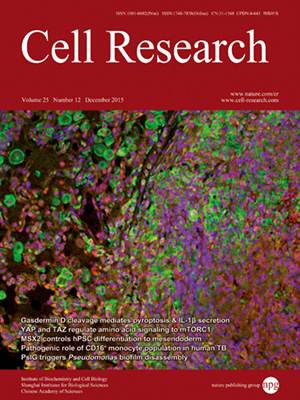
Volume 25, No 12, Dec 2015
ISSN: 1001-0602
EISSN: 1748-7838 2018
impact factor 17.848*
(Clarivate Analytics, 2019)
Volume 25 Issue 12, December 2015: 1368-1371 | Open Access
LETTERS TO THE EDITOR
Development of the anterior-posterior axis is a self-organizing process in the absence of maternal cues in the mouse embryo
Ivan Bedzhov1,*, Monika Bialecka1,*, Agata Zielinska1, Joanna Kosalka1, Francesco Antonica1, Amelia J Thompson1, Kristian Franze1 and Magdalena Zernicka-Goetz1
1Department of Physiology, Development and Neuroscience, University of Cambridge, Downing Street, Cambridge CB2 3DY, UK
Correspondence: Magdalena Zernicka-Goetz,(mz205@cam.ac.uk)
Establishment of the anterior-posterior (AP) axis in the mouse embryo is crucial for proper induction of the germ layers. Despite this importance, it is unclear whether specification of the AP axis is an autonomous process or if it requires an embryonic-maternal interaction at the time of implantation. By embryonic day 5.5 (E5.5), the combined activities of Nodal, GDF3 and the Cripto co-receptor generate a proximal-distal gradient that establishes a signaling center at the distal tip of the embryo ― the distal visceral endoderm (DVE). This proximo-distal asymmetry is transformed into the AP axis as the DVE cells migrate. DVE cells express the Nodal antagonists, Lefty1 and Cer1, which specify the anterior identity of the underlying epiblast1. The expression of these key DVE markers is already triggered before implantation2,3,4. Cells that express Lefty1 and Cer1 in the late blastocyst contribute to DVE formation, together with cells that acquire de novo Cer1 and Lefty1 expression after implantation3,4,5. This pre-implantation expression of the Nodal antagonists led to the suggestion that the DVE, and therefore the AP axis, arise independently of any interaction between mother and embryo.
10.1038/cr.2015.104
FULL TEXT | PDF
Browse 2339


